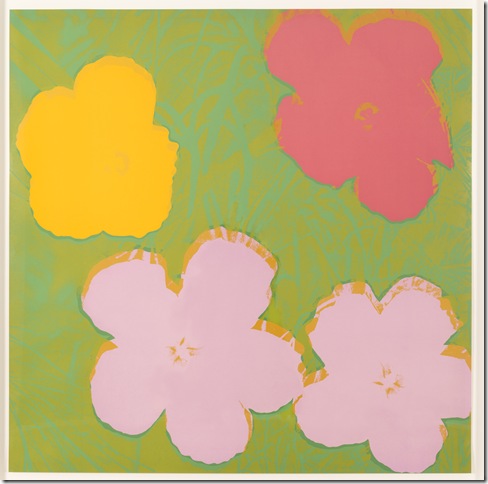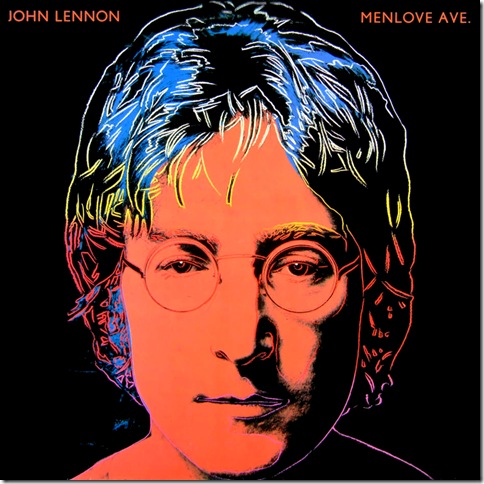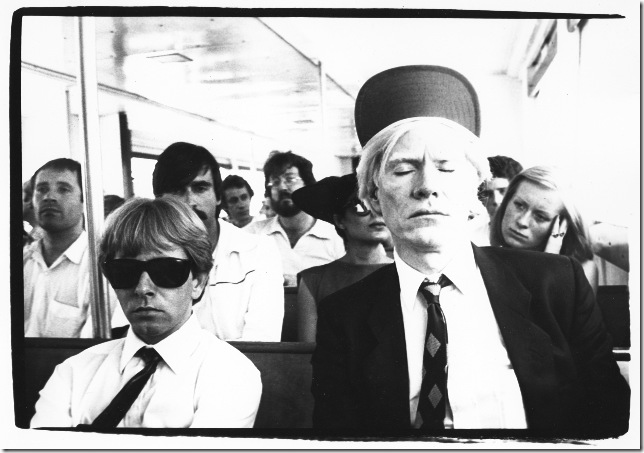Queen Elizabeth II of the United Kingdom (1985), by Andy Warhol. (Marc Bell collection)
A pastel-pink print featuring the word Macintosh and its logo in rainbow colors was the first Andy Warhol silkscreen Marc Bell bought for the practical purpose of adorning his Apple dealership in New York. The Boca Raton entrepreneur now owns a substantial amount of them and is letting them go for the first time.
Not to worry. They haven’t gotten very far. The Boca Raton Museum of Art has the complete silkscreen suites from his collection on display through May 1.
Six years ago, another of Bell’s collections was featured at the Museum under The Magical World of M.C. Escher. But unlike Escher’s work, Warhol’s art is colorful and it was that bold use of color that attracted him from the start.
“It’s fun,” he said, adding that the Mac print remains “very dear to my heart.”
Loud colors and bold graphics is what museum goers always expect to see in any exhibition revolving around Warhol. This 3-in-1 show, called 3x Warhol, pairs the most known aspects of his work and the least known.
The most recognizable pieces are housed in the Warhol Prints from the Collection of Marc Bell gallery space. Leading the way is bright yellow and pink wallpaper featuring a cow’s head. The cloning effect and vibrant hues announce we are about to enter Warholand, where repetition builds reputation, as the artist once professed.
It is here that we find portraits of Marilyn Monroe, Queen Elizabeth and Chairman Mao, along with dollar signs, Mickey Mouse and 20 iconic Campbell’s soup cans from 1968 and 1969.
The soup can prints, based on the 32-canvas edition from 1962, appear to look the same at first glance. The industrial, mechanical quality of the top 10 — among which is the classic Tomato flavor — recalls the artist’s wishes to “be a machine.” But it softens up when it reaches the bottom 10, where fonts and colors get more playful. Have fun reading the labels, which range from Hot Dog Bean to Chicken ‘N Dumplings.
Flowers (1964), by Andy Warhol. (Marc Bell collection)
There is no tragedy or death here. No car crashes or electric chairs. Instead we are greeted by the glowing shapes of four gigantic flowers sitting flat against a grainy black-and-green background. The design in Flowers (1964) is simple, primitive and devoid of detail on purpose. The original two-page magazine foldout that inspired it had seven flowers. Warhol cut three and had the photo run several times through the photostat machine at The Factory. He wanted only the essence to remain.
That mass-produced, assembly-line approach to the creative process is what had sentimental critics of the time horrified. Though a minority, there are still those who believe his pantry-inspired works did nothing to elevate art.
“People shouldn’t judge,” said Bell. “They say: oh, it’s commercial. You know what? It doesn’t make it less art.”
Kathy Goncharov, the Museum’s curator of contemporary art, agrees that the artist remains highly popular and was even ahead of his time.
“Certainly enough scholars, art historians and museums take him seriously,” Goncharov said. “He really anticipated a lot of the good and the bad to come.”
Menlove Ave. (1986), by Andy Warhol. (EMI Group Ltd. / Universal Music Group)
From a scholarly point of view, the record-covers portion of the exhibition is the most interesting. Warhol on Vinyl: The Record Covers, 1949–1987, on loan from the Cranbrook Museum, is dedicated to his career as illustrator and graphic designer. The section includes more than 50 record covers ranging from classical music, jazz and rock-n-roll to soundtracks and international music.
Some of these are legendary. There is the controversial banana cover from 1967 for the Velvet Underground & Nico album, which instructed the listener to “peel slowly’ the yellow banana sticker and “see” a pink banana emerge.
Also on display is the memorable Rolling Stones’ Sticky Fingers cover, which features a man’s groin in tight jeans and an actual working zipper. The model’s underwear is revealed when you pull it down. The identity of the jeans model on the black-and-white cover has been long disputed, with The New York Post asking “whose crotch is it anyways?” as recent as last year. Warhol never revealed the identity behind the bulgy crotch.
The most insightful section is Bob Colacello: In and Out with Andy, which consists of about 50 black-and-white photographs taken by the editor of Interview magazine from 1971 to 1983. It is the first solo museum exhibition by the self-proclaimed “accidental photographer” who documented the Warhol’s inner circle and New York social scene with a plastic Minox camera.
This loyal plastic companion, small enough to carry in a pocket, let him capture the raw and spontaneous poses of celebrities, aristocrats, and politicians in formal and informal settings. The candid, down-to-earth images feature subjects such as Mick Jagger, Diana Vreeland, Roman Polanski, Valentino, Liza Minnelli, Truman Capote, in playful moods, relaxing and sometimes trashed.
Andy Warhol With Rupert Smith, His Silkscreen Printer, on a Ferry to Fire Island (1979), by Bob Colacello. (Steven Kasher Gallery)
The Pop Art artist himself emerges as less of a workaholic and more of a party animal, giving out hugs and laughing. It’s a very different portrait from David Bowie’s Andy Warhol song: “He’ll think about paint and he’ll think about glue. What a jolly boring thing to do.”
Boring is not housed here. By Warhol’s own definition of a great picture — catching someone glamorous doing something unglamorous — there are tons of great pictures here. There is the artist, mouth wide open, grabbing a bite from his fork. He is sitting next to an unidentified man while his tape recorder rests on his lap.
“He called it his wife Sony,” said Goncharov of the tape recorder he took everywhere.
In another unflattering photo taken at his Naples Hotel Suite, the artist wears nothing but a white, long-sleeves shirt, jockey shorts and socks. Legs crossed and eyes barely open, he appears to be enjoying breakfast sitting on a floral couch. The lack of sunlight in the room suggests it is still dark outside.
In some cases, the titles provided by Colacello result more revealing than the images.
“Photographer Berry Berenson, Marisa’s kid sister, doles out vitamins to her actor husband Tony Perkins,” reads one caption from 1978. The word “vitamins” might get a few laughs.
Laughs, nostalgia and a few wild surprises in the form of video installations promise to make this an unforgettable exhibition, although its intention is the same as every Warhol show: to test his relevance against this crazy modern world.
To Bell, relevance is not even a question.
“If you enjoy looking at it, it’s relevant.”
If you go
3X Warhol, featuring Warhol Prints from the Collection of Marc Bell; Warhol on Vinyl: The Record Covers, 1949-1987; and Bob Colacello: In and Out With Andy, runs through May 1 at the Boca Raton Museum of Art, 501 Plaza Real, Mizner Park, Boca Raton. Admission: $12. Hours: 10 a.m. to 5 p.m. Tuesday, Thursday and Friday; 10 a.m. to 8 p.m. first Wednesday of the month; 12 p.m. to 5 p.m. Saturday and Sunday. Closed Mondays and holidays. Call 561-392-2500, or visit www.bocamuseum.org.
![Andy Warhol, Queen Elizabeth II of the United Kingdom [from Reigning Queens], 1985. © 2015 The Andy Warhol Foundation for the Visual Arts, Inc. / Artists Rights Society (ARS), New York. Courtesy the collection of Marc Bell. Andy Warhol, Queen Elizabeth II of the United Kingdom [from Reigning Queens], 1985. © 2015 The Andy Warhol Foundation for the Visual Arts, Inc. / Artists Rights Society (ARS), New York. Courtesy the collection of Marc Bell.](http://palmbeachartspaper.com/wp-content/uploads/2016/02/JACEK3064_thumb.jpg)


